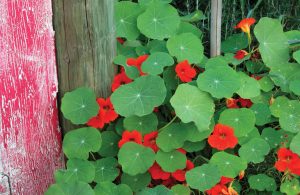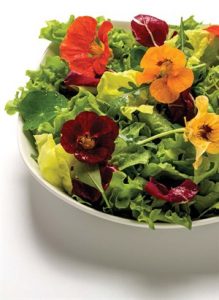Sally Benson — May 26, 2015

Yes, it’s an annual. But Tropaeolum, commonly known as nasturtium, neatly bridges the gap between ornamental and edible, and may be just the plant that ties together the garden that’s created to offer both beauty and bounty.
For today’s – and tomorrow’s – gardeners who are demanding “purpose” in the landscape, nasturtium provides lovely color all season long, plus an unusual and striking garnish at the dining table. Both the flowers and the foliage are often used in salads, dressing up that plate full of greens. The foliage can also be prepared much like spinach, either fresh or cooked.
Name: Tropaeolum
Common name: Nasturtium
Hardiness: Annual
Mature height: 12 inches to 10 feet
Mature spread: 1 to 3 feet
Classification: Annual pot or garden plant
Landscape use: Grow in containers and allow to trail; use as a quick-growing groundcover or train the trailing variety up a fence or garden obelisk
Ornamental characteristics: Very showy, fragrant, funnel-shaped, fivepetaled flowers sport spurs; blooms range from red through orange to yellow and cream and grow to about 2.5 inches wide; rounded foliage; climbing and bushy, sprawling types are available
Some folks even eat the seed pods, although I once was warned to stay away from seeds, as a few questionable sources report they contain toxic elements. (Maybe that’s why Dad called them “nasty little nasturtiums.” On the other hand, he was given to wordplay, so you never know. He was known to pluck the plant, flower, stem and leaf, and munch it before he left the garden.) And in case you’re concerned about your pets, the ASPCA reports that there’s no evidence of toxicity to dogs, cats or horses.
The flavor varies slightly from garden to garden, but very slightly. (A neighbor, whose soil is similar to mine, offered some extra nasturtium and they were tangier than the crop I’d grown. Perhaps a different seed strain?) Washed flowers and leaves offer a subtle, peppery taste; certainly not overwhelming, but enough to spice up a salad. Some liken the flavor to a radish, although I’ve found them to be a bit wimpier than that. Stems may be slightly sweet at first, then the aftertaste is strongly peppered. I’ve only used nasturtiums in fresh salads, primarily because I’m an admittedly lazy cook. If it takes much preparation, I’m not interested.
So, that’s the table; what do nasturtiums contribute to the garden?
Phots: iStock | morgana3
It’s hard to miss the brilliantly colored, showy blooms, offered in sunny colors ranging from red to orange to yellow, and sometimes cream. The funnel-shaped blooms, which have five petals and are spurred, sit atop rather long stalks. Many varieties have a spicy scent.
The unique foliage is rounded and presents itself like a parasol, with the petiole attached near the center of each leaf. Most leaves grow to about 3 to 4 inches round, but I’ve had several plants whose leaves have exceeded 5 inches – perhaps they were garden freaks.
There are quite a few varieties, most of them falling within two categories of growth habit: climbing types and bushy, sprawling types. It’s really just a matter of site conditions, as both types require similar care. Average to poor (!) soils are tolerated, and some afternoon shade is welcome in regions where summers tend to experience prolonged heat. The plants are not susceptible to significant insect or disease problems, although the occasional whitefly or aphid infestation may occur.
Nasturtiums grow quickly, offer color and rich foliage in container or garden settings, and provide a bit of Vitamin C, to boot. They’re the ideal starter plant for those who want more than aesthetics in the landscape. They’re plants with a purpose.
Cover Photo iStock | DaveAlan